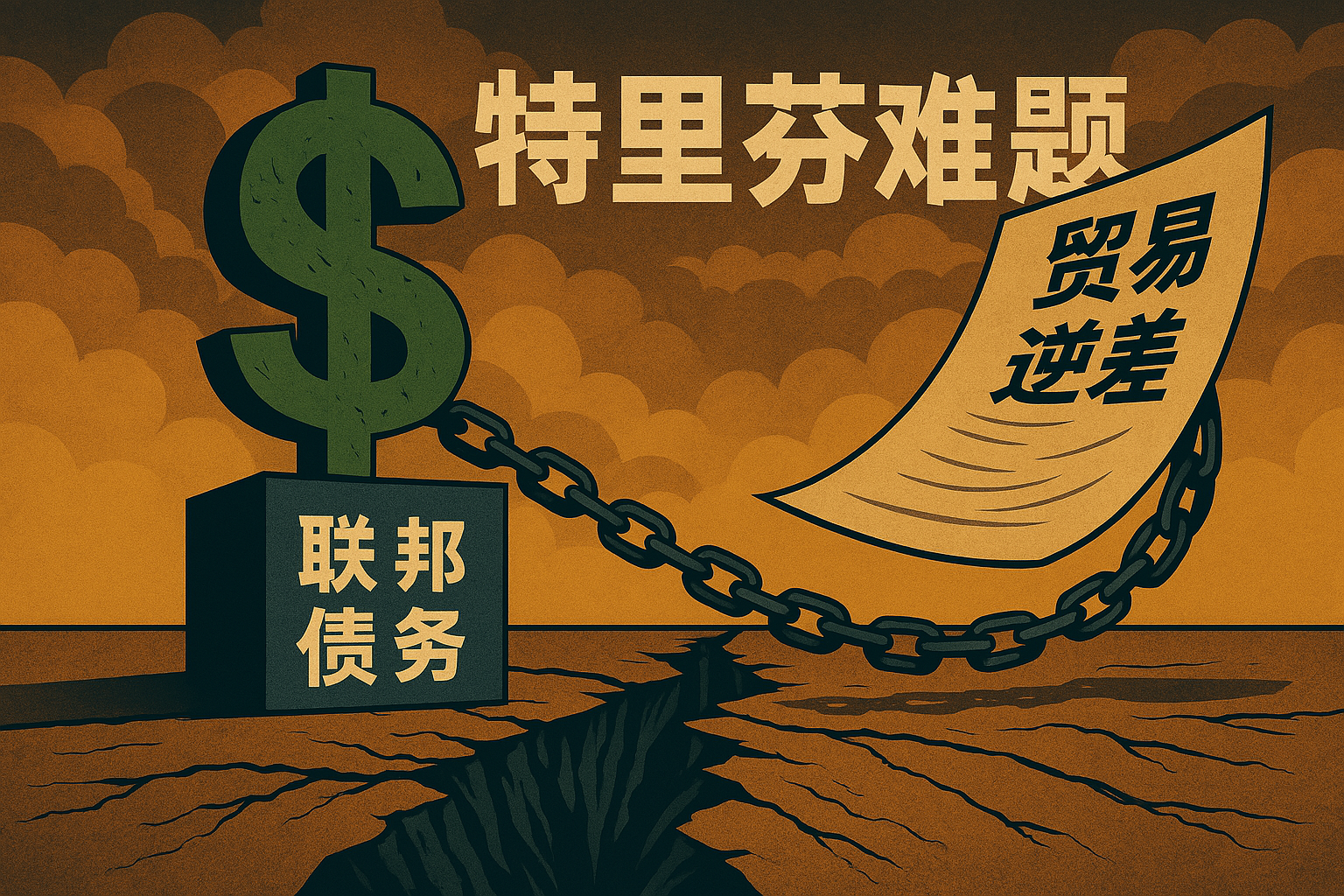關稅是刀,貨幣是盾:一次「美元霸權裂解」與「穩定幣崛起」的機會
美元不僅控制着全球貿易,更成爲了一個隱祕的經濟武器,誰控制了美元,誰就控制了全球的經濟命脈。更令人擔憂的是,這場戰爭將會從商品領域蔓延到貨幣領域,一場全球性的貨幣貶值競賽正在上演。這是一場沒有硝煙的戰爭,但每個人的錢包裏都已經響起了警報。
上周,美國總統特朗普掀起了一場關稅風暴,全球經濟瞬間被卷入了一場劇烈震蕩。美股暴跌,市值兩天蒸發 5 萬億美元,比特幣也難以幸免。但你知道嗎?這場關稅戰的真正殺傷力,其實藏在我們最熟悉、卻又最常被忽視的一樣東西裏——貨幣。
美國之所以敢如此囂張地舉起關稅大棒,並非僅憑貿易逆差這張牌,更關鍵的底牌是美元霸權。美元不僅控制着全球貿易,更成爲了一個隱祕的經濟武器,誰控制了美元,誰就控制了全球的經濟命脈。更令人擔憂的是,這場戰爭將會從商品領域蔓延到貨幣領域,一場全球性的貨幣貶值競賽正在上演。

那麼,普通人又該如何面對這樣一場沒有硝煙的戰爭呢?讓我們一層層揭開這場戰爭的真相,看看誰才是最終的贏家?不賣關子,直接先說答案:
出乎很多人意料,最終的贏家或許不是國家,而是去中心化的穩定幣。
首先,我們來看一下對各國對美國加稅的反應。
1. 強硬的與溫和的
面對美國總統特朗普於 2025 年 4 月 2 日宣布的對中國商品額外加徵 34% 關稅的決定,中國迅速作出強硬回應。
中國國務院關稅稅則委員會於 4 月 4 日宣布,自 4 月 10 日起,對原產於美國的所有進口商品在現行適用關稅稅率基礎上加徵 34% 關稅。此外,中國還對中重稀土等關鍵資源實施出口管制,並在世界貿易組織(WTO)提起訴訟,指責美國的關稅措施違反國際貿易規則 。這一系列措施顯示了中國在貿易爭端中維護自身權益的堅定立場。
隨後,美國又宣布如果中國不撤回報復性的 34% 關稅,就會再加徵 50% 的關稅。針尖對麥芒,互不相讓。

與中國的強硬相比,越南選擇了溫和政策。
作爲受影響最嚴重的國家之一,越南面臨着美國高達 46% 的關稅。越南政府迅速採取行動,尋求通過外交手段解決爭端。越南共產黨總書記蘇林與特朗普總統進行了電話會談,表達了將越南對美國商品的關稅降至零的意願,以換取美國取消對越南的高額關稅。
此外,越南政府請求美國將關稅實施日期推遲 45 天,以便雙方有時間進行談判。 越南副總理胡德福被派往美國,希望通過外交途徑解決關稅問題。
越南總理範明政在緊急內閣會議上強調,盡管面臨挑戰,越南仍將堅持 8% 或更高的 GDP 增長目標。 他指出,這一挑戰也是推動經濟結構調整的機會,旨在實現快速且可持續的發展,拓展市場,優化供應鏈。
其他國家的反應:
- 歐盟:歐盟委員會主席烏爾蘇拉·馮德萊恩表示,歐盟願意與美國進行談判,尋求工業品相互零關稅,但同時警告,如果談判失敗,歐盟將採取反制措施。
- 日本:日本貿易部長武藤洋二對美國的關稅決定表示遺憾,稱將考慮採取適當措施應對。
- 澳大利亞:澳大利亞總理安東尼·阿爾巴尼斯批評美國的關稅措施,稱其“毫無根據”,但表示澳大利亞不會採取報復性關稅。
現在看來,除了中國的反應強烈外,其他國家相對溫和。與中國形成鮮明對比的是越南,尤其是越南總理範明政說,這一挑戰也是推動經濟結構調整的機會。有點化壓力爲動力的味道,尤其值得細品。
其實,並不是越南膽子小,而是因爲這場關稅戰帶來的後果實在是其難以承受的。真要開打,不但美國難以承受,中國也難以承受,越南的溫和實屬不得已。
2. 關稅戰:割裂全球經濟的兩把刀
關稅戰,真要打起來,將會像兩把尖刀一樣去割裂全球經濟的脈絡,去無情地撕裂全球經濟的肌理。

2.1 刀一:供應鏈重構之痛
美國揮舞關稅大棒,其最直接、最顯性的效應,莫過於對全球供應鏈的劇烈衝擊。高額關稅就像一堵人爲設置的貿易壁壘,瞬間抬高了進口商品的成本。這不僅直接增加了美國消費者的開支,也使得依賴美國市場的中國制造業面臨巨大的出口壓力。
爲了規避高昂的關稅,全球產業鏈將被迫開始又一場浩浩蕩蕩的重構。過去三年(2022-2024年)的數據算是一場預演:
- 東南亞的崛起: 正如世界銀行的報告所顯示,東盟地區成爲了這場供應鏈轉移的最大受益者之一。2024 年,東盟地區的制造業外商直接投資(FDI)較 2020 年激增近 30%。這並非空穴來風。我們可以看到,電子、紡織、輕工等產業正加速向越南、泰國等東南亞國家轉移。例如,韓國三星電子就將其在中國的最後一家手機工廠關閉,加大了在越南和印度的投資。日本的服裝品牌優衣庫也開始增加在東南亞的生產比例,以降低對單一市場的依賴。這些企業的遷徙,直接帶動了當地的就業和經濟增長。
- 越南、墨西哥的“上位”: 越南和墨西哥憑借其地理位置和相對較低的勞動力成本,逐漸成爲美國企業在中國之外的重要制造備選地。以越南爲例,其對美國的出口額在過去三年內持續攀升,尤其是在紡織品、鞋類、電子元件等領域。墨西哥則因其與美國的地理和北美自由貿易協定(雖然在 2020 年被美墨加協定取代,但其影響仍在)的便利,吸引了大量汽車零部件、家電等產業的投資。短期來看,這些國家確實享受到了產業轉移帶來的紅利。
如今,隨着美國總統特朗普宣布對所有進口商品徵收10%的關稅,並對來自中國的商品額外徵收高達 50% 多的關稅,之前看似“雙贏”的產業鏈轉移格局將再次面臨嚴峻的衝擊。這就像地震後的地殼再次發生劇烈震蕩,原本已經開始遷移的“板塊”又將面臨新的不確定性。
對於那些已經將部分產能轉移到越南、墨西哥等地的企業來說,新的關稅政策無疑是當頭一棒。雖然他們可能規避了對華高達 50% 以上的額外關稅,但美國對所有進口商品徵收的10% 關稅仍然會增加他們的運營成本,削弱其價格競爭力。
更糟糕的是,如果這些企業在越南或墨西哥的生產仍然依賴從中國進口的零部件和原材料,那麼這些中間產品的成本也會因爲中國高達 50% 以上的關稅而大幅上升,最終導致其整體生產成本不降反升。
這場新的關稅衝擊還將加速全球供應鏈的進一步分散化和區域化。企業可能會更加傾向於在更靠近最終消費市場的地區建立生產基地,或者在多個國家布局產能,以降低對單一國家或地區的依賴。這種趨勢可能會導致全球貿易格局更加復雜,供應鏈的效率進一步降低,並增加企業的管理成本。
總而言之,新的關稅政策就像一把更加鋒利的刀,不僅會加劇原有的供應鏈重構之痛,還會對全球經濟的各個環節造成更廣泛、更深遠的影響。原本已經開始適應新格局的企業和國家,又將被迫面對新一輪的調整和挑戰。
2.2 刀二:“滯脹陷阱”的威脅
正如著名投資家 Ray Dalio 所警示的那樣,關稅就像給全球經濟注入了一種“滯脹”的毒藥。出口國因爲需求減少而面臨通貨緊縮的壓力,而進口國則因爲商品價格漲而感受到通貨膨脹的痛苦。這種增長停滯與通貨膨脹並存的局面,正是經濟學家最爲頭疼的“滯脹陷阱”。

讓我們來看看美國和主要出口國的實際數據表現:
- 美國通脹的“節節攀升”: 自 2024 年底美國關稅政策進一步升級以來,我們可以清晰地看到美國消費者物價指數(CPI)的持續漲。根據美國勞工統計局的數據,截至 2025 年 2 月,美國 CPI 指數較 2024 年底累計上漲了 0.684%。其中,受關稅影響較大的商品,如電子產品、服裝、家具等,價格漲幅更爲顯著。這直接導致美國民衆的生活成本不斷攀升,實際購買力下降。美國的年化通脹率約爲 2.8%~3.0%,遠高於 2% 的控制目標。
- 出口國的“寒意”: 對於像中國、韓國、德國等以出口爲導向的經濟體來說,美國加徵的關稅無疑是一記重拳。短期內,這些國家對美國的出口需求大幅萎縮,導致企業訂單減少,生產放緩。爲了消化過剩的產能,一些企業不得不降價銷售,從而面臨利潤下滑甚至虧損的困境。這會進一步影響企業的投資意願,甚至可能引發裁員潮,加劇失業風險。以中國爲例,根據 Economist Intelligence Unit 分析,預計中國的 GDP 增長率在 2025-2027 年可能降低 0.6%~2.5%,具體取決於關稅強度。
一國之內的“滯脹陷阱”的可怕之處在於,傳統的貨幣政策往往難以同時解決增長停滯和通貨膨脹的問題。如果央行採取寬松的貨幣政策來刺激經濟增長,可能會進一步加劇通貨膨脹;而如果採取緊縮的貨幣政策來抑制通脹,又可能會導致經濟進一步下滑。這使得各國政府在制定經濟政策時面臨兩難的選擇。
你需要注意的是,這一次關稅戰造成的“滯漲”不是一國之內的滯脹,而是全球性的,對於進口國來說是通脹,對於出口國來說是停滯。解決這種全球性滯脹的難題,其復雜性遠超一國之內的困境。

對於進口國而言,如美國,其面臨的主要挑戰是不斷攀升的物價。爲了抑制通脹,傳統的做法是提高利率。然而,在經濟增長已經因爲關稅和供應鏈中斷而放緩的情況下,加息可能會進一步打擊經濟活動,甚至引發衰退。
而對於出口國,如中國,其面臨的主要問題是需求不足導致的經濟增長放緩。爲了刺激經濟,通常會採取降息、增加信貸投放等寬松的貨幣政策。然而,在全球貿易緊張的背景下,這種做法可能會導致資本外流和本幣貶值,進一步加劇與美國的貿易摩擦。
因此,這種全球性的滯脹困境,使得任何單一國家的政策都難以奏效,甚至可能適得其反。進口國和出口國面臨着截然不同的政策困境,任何一方的單邊行動都難以找到平衡點,更難以在全球範圍內形成合力來解決問題。
這也是爲什麼 Ray Dalio 等經濟學家對這種局面感到擔憂的原因,因爲它預示着全球經濟可能進入一個長期低增長、高通脹的艱難時期。
2.3 小結
綜上所述,這場關稅戰,正如兩把無形利刃,悄無聲息地撕裂着全球經濟的神經。
- 第一把刀,供應鏈重構之痛,使得全球企業不得不付出巨大的成本調整生產布局,效率降低,最終由消費者承擔更高的價格。
- 第二把刀,“滯脹陷阱”的威脅,則讓各國政府陷入兩難境地,既要應對通貨膨脹的壓力,又要避免經濟增長進一步放緩,傳統的貨幣政策工具捉襟見肘。
面對供應鏈的斷裂和滯脹的風險,一些國家可能會將目光投向自己的唯一盾牌——貨幣。一場以鄰爲壑的貨幣貶值競賽,或許正在悄然拉開序幕。
3. 貨幣之盾:飲鴆止渴的毒藥
歷史的迷霧深處,經濟的時光機一次又一次地重復着相似的故事。人類總是習慣於從歷史中獲得教訓,卻又往往忽視這些教訓。貨幣戰爭,這個看似專業且復雜的術語,其實早已反復地在人類經濟史中上演過。
今天,這把“貨幣之盾”再次被各國所用,似乎能夠暫時緩解經濟的劇痛,但歷史告訴我們,它其實是一劑名副其實的飲鴆止渴的毒藥。

3.1 大蕭條中的貨幣貶值
20 世紀 30 年代的大蕭條時期,各國經濟紛紛陷入低迷與通貨緊縮的困境。爲了刺激出口、拯救經濟,各國爭相貶值自己的貨幣。1931 年,英國率先離開金本位制,允許英鎊自由浮動。英鎊兌美元迅速貶值約 30%,隨之而來的,是英國出口價格優勢大增,出口出現短暫回升。
英國此舉在全球掀起了一場狂風驟雨。法國、德國、意大利紛紛跟進,將貨幣貶值作爲經濟恢復的工具。這場競爭性貶值引發了連鎖反應,各國之間互相築起高額的關稅壁壘,試圖保護國內市場。但現實卻異常殘酷,全球貿易量因此劇烈下跌。據國際貨幣基金組織(IMF)的數據,從 1929 年到 1933 年,全球貿易規模下降超過 60%,加劇了經濟衰退,使各國失業率飆升,美國的失業率甚至超過了 25%。
3.2 亞洲金融危機中的貨幣貶值
如果說大蕭條時代的教訓尚且遙遠,那麼最近的貨幣戰爭就不得不提 1997 年的亞洲金融危機。當時,亞洲諸多經濟體經歷了高速增長後積累了巨額外債,熱錢湧入導致資產價格飛漲。當外資聞風撤離時,泰銖、印尼盾、馬來西亞林吉特等東南亞貨幣紛紛崩盤。
泰國首先於 1997 年 7 月宣布放棄匯率盯住美元政策,泰銖短時間內暴跌超過 50%。爲了維持出口競爭力,其他國家迅速跟進貶值,但隨之而來的卻是更猛烈的資金外逃。韓國在短短幾個月內外匯儲備耗盡,被迫向國際貨幣基金組織申請高達 580 億美元的緊急援助。
貶值的貨幣帶來了短暫的出口競爭力,卻也造成了嚴重的通貨膨脹與經濟衰退。印尼甚至爆發了大規模社會動蕩,總統蘇哈托被迫下臺。數據顯示,印尼在危機期間通貨膨脹率一度超過 70%,失業率劇增,社會陷入了混亂。
歷史的回響警示我們:貨幣貶值看似簡單的經濟工具,實際卻隱藏着難以預測的巨大風險。一旦各國競相貶值貨幣,不僅出口優勢短暫且不可持續,更會帶來全球資本市場的大動蕩,造成經濟長期的衰退與失衡。
但是,貨幣之盾的短期有效性,將會誘惑更多的國家走向萬劫不復的深淵。

3.3 貨幣貶值:不得不抓的救命稻草
在今天這場關稅戰中,各國再次被推到了貨幣貶值的懸崖邊緣。面對出口急劇萎縮、失業潮逼近的威脅,貶值貨幣成了各國政府眼中迫不得已的“救命稻草”。但歷史清楚地告訴我們,這根稻草並非救贖,而是經濟惡化的催化劑。
回看最近的數據,2025 年 4 月關稅新政出臺後,人民幣兌美元從 1 美元兌 7.05 元迅速跌至 7.20,創下近兩年來的新低;越南盾也迅速跟隨,兌美元貶值超過 6%;韓元、新臺幣、馬來西亞林吉特甚至歐元等貨幣,也無一例外地選擇了寬松的貨幣政策。這種競爭性貶值的邏輯簡單而殘酷:本國貨幣貶值後,出口商品在國際市場上顯得更爲廉價,從而暫時提振出口。
但這種短期繁榮的背後,卻隱藏着巨大的危機隱患。一旦貨幣持續貶值,本國資產的實際價值必然縮水,外資出於避險心理,會迅速撤離。以 2024 年土耳其爲例,裏拉在一年內貶值超過 40%,隨即引發外資大規模撤離,外匯儲備迅速消耗,通貨膨脹率飆升至 85% 以上,社會生活成本急劇漲,經濟瀕臨崩潰邊緣。
更令人擔憂的是,當貨幣貶值變成全球各國不得不採取的防守手段時,全球資本市場會陷入恐慌性的流動,資金大量湧入美元資產。此時,美國自身將陷入“美元陷阱”,美元的迅速升值壓垮美國的本土制造業,全球經濟的流動性枯竭,“雙輸”局面將不可避免地降臨。
事實上,如果不是美國,其他任何國家,如果不想做帶頭大哥了,提出對等關稅都是一種合理的要求。但是,美國不一樣,因爲美元霸權的存在,所謂的貿易逆差並不像美國說的那樣不公平,或者說貿易逆差只是部分真相。
4. 美元霸權下的貿易逆差
要理解美元霸權,我們首先要追溯到二戰之後。布雷頓森林體系確立了美元與黃金掛鉤的地位,使得美元成爲全球主要的儲備貨幣和結算貨幣。然而,這個體系在 1971 年尼克松政府宣布美元與黃金脫鉤後瓦解。
那麼,美元是如何在金本位崩潰後依然保持其霸主地位的呢?
4.1 美元霸權的形成
這其中一個關鍵因素就是“石油美元”體系的建立。在20世紀70年代,美國與沙特阿拉伯達成了一項具有裏程碑意義的協議。沙特阿拉伯同意以美元作爲其石油出口的唯一結算貨幣,而美國則承諾爲沙特提供安全保障。由於石油是全球經濟的命脈,這項協議使得全球大部分的石油交易都必須以美元進行。
想象一下,世界各國都需要購買石油來維持經濟運轉。而購買石油的唯一方式就是擁有美元。這就像在一個大型的國際市場裏,只有一種通用的“入場券”——美元。爲了獲得這張“入場券”,各國就必須通過向美國出口商品和服務來賺取美元,或者持有美元資產。
除了石油美元體系,美元作爲全球主要的儲備貨幣也進一步鞏固了其霸權地位。各國央行爲了應對國際收支平衡、幹預外匯市場以及作爲國家財富的儲存,都需要持有一定數量的外匯儲備。由於美國經濟體量龐大、金融市場發達且具有相對的穩定性,美元自然而然地成爲了各國央行的首選儲備貨幣。

根據國際貨幣基金組織(IMF)的數據,截至 2024 年底,美元在全球外匯儲備中的佔比仍然高達 57.8% 左右,遠超歐元、日元和英鎊等其他貨幣,見上圖。這意味着,全球超過一半的外匯儲備都是以美元形式存在的。如果你對美元霸權是如何形成的感興趣,推薦看一下《逃離「通貨陷阱」,回到「時間本位」》,這裏不只是美元這一個通貨,而是幾乎把所有的通貨的歷史都梳理了一下。
4.2 美元霸權帶來的“特權”:低成本融資與鑄幣稅
正是由於美元的特殊地位,美國得以享受其他國家無法比擬的“特權”。其中最顯著的兩個方面就是低成本融資和鑄幣稅。
低成本融資: 由於全球對美元資產(如美國國債)的需求巨大,美國可以以相對較低的利率借入資金。這就像一個信譽極佳的企業,更容易獲得銀行的低息貸款。其他國家如果出現貿易逆差,往往會面臨本國貨幣貶值、融資成本上升的壓力。但美國由於美元的霸權地位,這種壓力相對較小。
舉個例子,即使在美國政府債務不斷攀升的情況下,全球投資者依然願意購買美國國債,這在一定程度上壓低了美國的借貸成本。想象一下,如果其他國家出現如此龐大的債務,其國債收益率很可能會大幅飆升。
鑄幣稅: 鑄幣稅是指發行貨幣所獲得的收益與發行成本之間的差額。對於美國來說,由於美元是全球主要的儲備貨幣,許多國家都需要持有美元。這相當於美國可以“無償”地獲得一部分財富,因爲其他國家爲了持有美元,需要向美國出口商品和服務。
你可以把這想象成一個擁有全球通用貨幣發行權的“銀行家”,他只需要印制鈔票,就可以在全球範圍內購買商品和服務。雖然實際操作中並非如此簡單,但美元的全球地位確實賦予了美國一定的“鑄幣稅”收益。

4.3 貿易逆差只是部分真相
當我們討論貿易逆差時,往往只關注商品和服務的進出口。但實際上,國際貿易還包括資本的流動。在美元霸權下,美國的貿易逆差往往伴隨着大量的資本淨流入。
這是因爲,當美國從其他國家購買商品和服務時,美元會流向這些國家。而這些國家往往會將賺取的美元重新投資到美國的金融市場,例如購買美國國債、股票、房地產等。這種資本的回流在一定程度上彌補了美國的貿易逆差。
你可以把這想象成一個大型的購物中心。顧客(其他國家)在美國的商店(美國經濟)裏購買商品,然後又把賺到的錢存回了購物中心自己的銀行(美國的金融體系)。
根據美國商務部的數據,多年來,美國一直保持着貿易逆差,但與此同時,美國的金融帳戶卻呈現出順差,這意味着流入美國的資本超過了流出的資本。這在一定程度上解釋了爲什麼美國可以長期維持貿易逆差而不會引發嚴重的經濟危機。

4.4 特裏芬難題:美元霸權下的內在矛盾
美元作爲全球儲備貨幣,其地位本身就蘊含着一個著名的經濟學難題——特裏芬難題(Triffin Dilemma)。這個難題是由美國經濟學家羅伯特·特裏芬在 20 世紀 60 年代提出的。
特裏芬指出,爲了滿足全球經濟發展對美元不斷增長的需求,美國必須持續地輸出美元,這也就意味着美國需要長期保持貿易逆差。因爲只有通過貿易逆差,美元才能流向世界各地,成爲其他國家的儲備貨幣和交易媒介。
然而,持續的貿易逆差最終會導致美國的債務不斷累積,美元的信譽也會受到質疑。如果美元的信譽下降,各國可能會減少持有美元,轉而選擇其他貨幣作爲儲備,這將動搖美元的霸權地位。
這就形成了一個兩難的境地:爲了維持全球經濟的流動性,美國需要保持貿易逆差;但長期的貿易逆差又會威脅到美元的長期穩定。
一句話,帶頭大哥不好做。
4.5 小結:美元霸權下的貿易逆差
總而言之,在美元霸權的背景下,美國的貿易逆差具有其特殊性。它不僅僅是簡單的商品和服務的進出口差額,更與美元作爲全球儲備貨幣和結算貨幣的地位息息相關。美元霸權賦予了美國諸多經濟上的“特權”,但也帶來了內在的矛盾和潛在的風險。
回到當前的關稅戰。美國總統特朗普聲稱要通過加徵關稅來減少美國的貿易逆差,認爲這可以保護美國的就業和產業。但從美元霸權的角度來看,美國的真實意圖可能更加復雜。
一些分析認爲,美國發起關稅戰的真正目的並非僅僅是爲了減少貿易逆差,而是爲了維護其在全球經濟和科技領域的領導地位。通過對特定國家和行業的關稅施壓,美國可能希望迫使這些國家在貿易規則、知識產權保護、技術轉讓等方面做出讓步。
此外,關稅也可以被視爲一種地緣政治工具,用於調整與特定國家的經濟和政治關系。簡單說,那就是由於美元霸權的存在,關稅正在被“武器化”。
對於世界來說,解決美元霸權才是解決美國關稅武器化的根本解。

5. 美元霸權的“阿喀琉斯之踵”
美元的霸權猶如古希臘英雄阿喀琉斯,無論外表多麼強大,也總有一個致命弱點。美元霸權強大的背後,正隱藏着多個致命的經濟和政治漏洞。一旦這些漏洞被市場力量或政治變化所刺穿,美國及全球經濟將迎來一場前所未有的動蕩。
5.1 過度負債的不可持續性
要理解美元霸權的問題,我們首先來看數據。截至 2025 年 3 月,美國聯邦政府債務已超過 36.56 萬億美元,相當於其國內生產總值(GDP)的 124% 以上。這個數據究竟意味着什麼?簡單來說,美國政府每年產生的債務規模已經超過了其全年經濟生產的總和。
然而令人奇怪的是,美國巨額債務並未帶來更高的融資成本。相反,過去幾十年來,美國依靠美元的國際地位不斷壓低了借款利率,使得舉債成本異常低廉。美國國債收益率長期維持低位——比如,2020-2024 年間,美國 10 年期國債收益率平均僅爲 2% 左右,而其他負債較高國家,如巴西,其同期國債收益率動輒超過 10% 甚至更高。
這種巨額債務和低成本融資看似美好的背後,其實是一個難以爲繼的經濟奇跡。一旦全球投資者對美國債務償還能力失去信心,債務成本便會快速上升,美元信用將遭遇嚴峻考驗。
2008 年次貸危機,正是美元霸權第一次被嚴重懷疑的時刻。雖然最後聯準會憑借超大規模的量化寬松(QE)救場,美國暫時渡過難關,但也埋下了更深的債務和通脹風險。
從 2020 年新冠疫情以來,美國聯邦政府和聯準會又進行了超過 4.5 萬億美元的 QE。如此驚人的“印鈔機”式放水操作,再次讓美元信譽置於懸崖邊緣。

5.2 對美元體系的全球抵制浪潮
美國長期以來通過美元體系實施經濟制裁與貿易限制,這導致了世界各國對美元的嚴重不滿。數據顯示,僅 2010 至 2024 年間,美國財政部通過美元清算體系對其他國家、企業、個人實施超過 2 萬次金融制裁和資產凍結。
舉個最近的例子,2022 年俄烏衝突爆發後,美國迅速對俄羅斯實施了史上最嚴厲的金融制裁:凍結俄羅斯約 3000 億美元外匯儲備,禁止俄羅斯銀行進入SWIFT(環球銀行間金融通信協會)美元清算體系。
面對美元的“金融霸權”,全球越來越多國家開始主動尋求替代方案,試圖繞過美元清算體系。以金磚國家爲例(巴西、俄羅斯、印度、中國、南非),2023 年以來加速推進非美元貿易結算協議。數據顯示,僅 2024 年,中俄貿易中非美元結算佔比已超過 70%;印度與阿聯酋2023年籤訂協議,用盧比結算雙邊貿易;巴西和阿根廷則積極推進本幣交易,以減少對美元的依賴。
更進一步,2024 年 8 月,金磚峯會上正式提出建立“金磚共同貨幣”,這一構想雖然仍處在探索階段,但無疑顯示出去美元化趨勢正在加速蔓延。

5.3 去中心化貨幣的挑戰
如果說各國的去美元化努力還僅僅是初步嘗試,那麼數字貨幣的迅猛發展則爲全球金融市場開闢了一個全新的戰場。
以比特幣爲代表的加密貨幣,因其去中心化、無法被單一國家控制的特點,逐漸吸引了全球越來越多投資者、企業乃至政府的關注。根據劍橋大學2024年的研究報告,全球已有超過 3 億人口擁有或使用過加密貨幣。
比特幣雖然尚未真正挑戰美元作爲全球儲備貨幣的地位,但其提供了一種全新的財富儲存和跨境支付方案。薩爾瓦多於2021年成爲全球首個將比特幣定爲法定貨幣的國家,隨後中非共和國於2022年效仿。盡管這些國家規模不大,但此類行動向全球發出了明確的信號:貨幣主權未必必須依賴美元體系。
5.4 美元霸權終結的可能路徑
從歷史經驗看,沒有哪一種貨幣的霸權是永恆不變的。曾經的西班牙銀元、荷蘭盾、英鎊,都曾在歷史舞臺上風光無限,卻最終衰落。美元雖仍強大,但不可避免地也會遭遇周期性挑戰。
專家認爲可能導致美元霸權終結的路徑,大致有三條:
第一,全球多極化趨勢持續加速。美國國際經濟地位逐漸下降,全球經濟重心轉移至東亞、南亞、中東等新興市場。更多國家基於自身利益,推動非美元結算機制普及化。美元作爲儲備貨幣的需求逐步減少,美元霸權被稀釋。
第二,美債信用體系被市場嚴重質疑,美國無法持續低成本融資,債務利率飆升導致政府債務危機爆發,美元信譽遭遇空前危機。這種情況下,全球資本市場將拋售美元資產,促使美元信用崩潰,美元體系瞬間瓦解。
第三,數字貨幣迅速普及,使全球跨境貿易不再高度依賴美元清算體系。尤其是類似數字人民幣、去中心化數字貨幣比特幣等成爲主流國際支付工具後,全球對美元的依賴程度大幅降低,美元不再具備絕對的“金融武器”功能,霸權自動終結。
但是,去中心化的穩定幣,尤其是與美元資產無關的去中心化化穩定幣,將會成爲替代美元的有力競爭者。

6. 去中心化穩定幣終結美元霸權
過去十年,加密貨幣的迅速興起讓人們看到了傳統貨幣體系之外的更多可能性。而在這一趨勢中,穩定幣憑借其相對穩定的價值錨定、便捷的跨境支付功能,以及去中心化潛力,逐漸成爲改變現有貨幣格局的重要力量。但值得注意的是,並非所有的穩定幣都有資格成爲未來終結美元霸權的“候選者”。
6.1 穩定幣的分類及其運作機制
爲了深入理解穩定幣,我們先把穩定幣分成三大類:
第一類:法幣抵押型穩定幣
法幣抵押型穩定幣,顧名思義,是指以美元、歐元等傳統法定貨幣爲抵押,發行的與這些貨幣保持 1:1 價值錨定的代幣。最著名的例子包括 USDT(Tether)和 USDC(USD Coin)。截至 2025 年 4 月 9 日,USDT 市值高達 1400 億美元,USDC 則爲 600 億美元,兩者合計佔據了穩定幣市場超過85%的份額,詳見下圖。
這類穩定幣的最大優勢在於易理解且風險較低,只要發行方真實持有與發行量等額的法幣資產,其代幣價格就能得到有效的保障。但也正因爲如此,這類穩定幣的穩定性和可靠性高度依賴於中心化機構(例如 Tether、Circle)的信用。
然而,問題的核心正在此處——中心化的機構不可避免地會受到政治力量、司法管轄和金融監管的制約。
第二類:加密貨幣抵押型穩定幣
加密貨幣抵押型穩定幣以其他加密資產(如 ETH、BTC)作爲抵押,通過超額抵押保證價格穩定,代表性的有 DAI(MakerDAO)以及近年興起的 LUSD(Liquity)等去中心化穩定幣。
MakerDAO 在 2024 年 8 月進行了重大品牌重塑,將其名稱更改爲 Sky,同時將其穩定幣 DAI 更名爲 USDS。爲了講述方便,我們暫且還是延用老的名稱。

截至2025年3月底,DAI + USDS 的市值超過了 108 億美元,是加密貨幣抵押型穩定幣的領頭羊,見上圖。這類穩定幣在去中心化程度上遠勝法幣抵押型穩定幣,因爲其抵押品是去中心化的加密資產,而抵押和發行過程也都通過智能合約自動完成,理論上不存在人爲操縱空間。
第三類:算法穩定幣(無抵押型)
算法穩定幣的概念最早由 Basis 和後來的 TerraUSD(UST)提出,這類穩定幣並無任何法幣或其他資產做直接抵押,而是通過復雜的算法自動調節供應量,嘗試將價值錨定到法幣(通常是美元)。2022 年 TerraUSD 的崩潰曾導致市場劇烈動蕩,市場一度認爲算法穩定幣已失敗,但近期的 Frax 和 Reflexer 等新算法穩定幣嘗試逐漸恢復市場信心。
盡管如此,由於缺乏真實資產背書,算法穩定幣的長期穩定性仍未得到市場認可。
6.2 爲什麼 USDT 和 USDC 無法終結美元霸權?
回到本文最核心的問題——USDT 和 USDC 這些以美元資產背書的穩定幣爲何難以取代美元成爲新霸權貨幣?
關鍵原因在於:它們的價值根基仍然牢牢綁定於美元資產,而美元資產的控制權歸屬於美國政府及其監管機構。
首先,讓我們來看看實際的數據和例子:
2022 年俄烏衝突期間,美國對俄羅斯發起了史無前例的金融制裁,凍結了俄羅斯超過 3000 億美元的外匯儲備,其中就包括大量通過美元資產支持的金融工具。隨後,美國財政部更是明確發出警告,要求所有受美國管轄的穩定幣發行機構凍結任何與俄羅斯實體相關的帳戶。
Circle 公司(USDC發行方)隨即迅速響應,凍結了價值數百萬美元的 USDC 帳戶。這一舉動清晰地展示了一個事實:USDC 及類似的美元資產抵押型穩定幣本質上只是美元的區塊鏈版本,本質並未改變——其資產依舊受到美國監管當局的強大管轄。
再來看 USDT。2021年至2024年,USDT先後應美國司法部(DOJ)與紐約州總檢察長辦公室(NYAG)的要求,凍結了數十個地址,總金額達數億美元。這也表明,即便 USDT 的發行公司 Tether 宣稱其註冊在英屬維京羣島,且不受美國司法管轄,但在全球美元結算網絡的制裁壓力下,Tether 仍然必須“低頭”配合執行凍結措施。
更爲關鍵的是,這種權力實際上與傳統金融系統的 SWIFT 系統一模一樣。美國只需要向任何美元資產支持的穩定幣發行商下達命令,即可迅速凍結帳戶、切斷資金鏈路。這就意味着,以美元資產爲抵押的穩定幣,根本無法脫離美元霸權的直接管控,也就無法真正取代美元在全球貿易與金融中的霸權地位。

6.3 真正能夠終結美元霸權的穩定幣——無美元資產抵押的去中心化穩定幣
那麼,真正能夠打破這一僵局的穩定幣,必然是與美元資產完全脫鉤的、不可封禁的、徹底去中心化的穩定幣。
這樣的穩定幣有什麼樣的特徵呢?我們以 MakerDAO 的去中心化穩定幣 DAI 爲起點,未來的理想穩定幣模型可能是:
- 抵押資產多樣化且去中心化:不再以美元或美元金融資產爲主要抵押品,而是以 BTC、ETH 等去中心化資產爲核心,甚至可能是黃金或其他非美元資產的代幣化形式。
- 徹底的去中心化治理機制:抵押、鑄幣、清算機制完全通過智能合約實現,任何中心化主體或國家力量都無法單方面控制或凍結資產。
- 無監管單點失敗風險:所有抵押資產分布於全球不同的節點,沒有一個政府或機構能夠單獨凍結或掌控,這也意味着這種穩定幣將完全脫離美國的金融霸權影響。
當穩定幣的抵押資產完全去美元化時,美國實際上被踢出了這個貨幣遊戲的舞臺中心,直接導致其一直以來享受的鑄幣稅收入徹底消失。
鑄幣稅本質上是美國依靠發行美元,讓全球主動持有美元資產所帶來的額外收益,例如美國政府每年依靠美元全球儲備地位節省高達數千億美元的利息成本(僅2023年美國國債利息節約成本估算便超過2500億美元)。
但當穩定幣完全轉向 BTC、ETH 或黃金等非美元資產後,全球各國和機構不再需要持有美元或美元債券作爲抵押資產,這意味着美國失去了以零成本印制美元“紙票”來換取全球真實商品的權利。
從此刻起,美國財政部再也不能像過去一樣,憑借美元的全球結算貨幣地位發行國債,輕易地獲得全球資金以低成本融資。這種穩定幣新格局實際上是釜底抽薪,直接斬斷了美國依靠鑄幣稅及低成本融資收割全球財富的隱形經濟通道。
6.4 小結:去中心化穩定幣是終結法幣霸權的關鍵
一旦這樣的去中心化穩定幣真正被廣泛採用,將徹底顛覆現有金融格局:
- 各國貿易將無需再經美元清算系統(如SWIFT),擺脫了制裁和凍結的威脅。
- 全球資金的自由流動性和安全性大幅提高,資金不會被任意封鎖或凍結,也不會被用作地緣政治鬥爭的武器。
- 資金成本大幅降低,不再需要向美元霸權繳納隱形的“鑄幣稅”和“美元稅”。
隨着區塊鏈技術和去中心化治理機制的成熟,未來全球經濟或許將逐漸從美元霸權的陰影中掙脫出來,迎來真正自由和開放的金融新時代。
去中心化、去美元化的穩定幣,將成爲一個新的世界貨幣、一個不會形成新的霸權的世界貨幣。

結語
美元的時代或將終結,並非因爲美國不再強大,而是因爲全球已不願將自身命運交給一張可以隨時變成武器的紙幣。
歷史一次次提醒我們:貨幣的背後從來都不只是冰冷的數字,更是人類的信任與自由。當美元一次次利用自己的霸權地位,將全球經濟拉入割裂和滯脹的深淵時,一個新的金融秩序將悄然崛起。
去中心化穩定幣的出現,不僅意味着金融工具的創新,更是人類貨幣自由精神的覺醒。真正安全的財富,從來不是依靠強權保障,而是依托技術和共識打造。未來的全球經濟,注定屬於那些無法被任何強權凍結和封禁的去中心化貨幣。
當穩定幣不再依賴美元資產作爲抵押,美元霸權也將隨之黯然失色。我們正站在一個時代的拐點上,見證的不僅是一場關稅戰爭的輸贏,更是貨幣霸權終結的歷史性時刻。
穩定幣不再依賴美元,最應該依賴什麼呢?比特幣,這個原生的加密貨幣。現在,開頭那個普通人應該如何面對的問題?答案也就自然浮現了。很簡單,從現在開始,留足生活費 DCA 比特幣。更多詳細的內容可以看一下《比特幣:長期主義者的終極避險方案?》。
或許多年以後,當人們回首今日時,會驚嘆地發現:
原來貨幣自由的黎明,就是在這樣一場無聲的戰爭中悄然開啓的。
或許它並不轟烈,卻將深刻改變世界。
聲明:
- 本文轉載自 [Mirror],著作權歸屬原作者 [Daii],如對轉載有異議,請聯系 Gate Learn 團隊,團隊會根據相關流程盡速處理。
- 免責聲明:本文所表達的觀點和意見僅代表作者個人觀點,不構成任何投資建議。
- 文章其他語言版本由 Gate Learn 團隊翻譯, 在未提及 Gate.com 的情況下不得復制、傳播或抄襲經翻譯文章。
相關文章

3074傳奇後對以太坊治理的思考

區塊鏈盈利能力和發行 - 重要嗎?

比特幣年第二章

Notcoin & UXLINK:鏈上數據比較

最後與當前牛市中的 NFT 和模因幣


